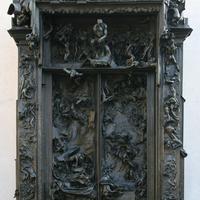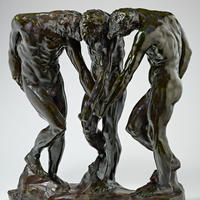More about Iris & B. Gerald Cantor Center for Visual Arts
Works at Iris & B. Gerald Cantor Center for Visual Arts

Contributor
Cantor Arts Center is a temple to Auguste Rodin, the largest collection of his stuff outside of Paris, but it also has some highly unlikely works by more recent and irreverent folk.
The museum is at Stanford, half-an-hour drive from San Francisco, depending on how you feel about speed limits. Downtown Palo Alto is only minutes away, with some casual cool eating places. The Rodin Sculpture Garden has 20 sculptures, including the epically terrifying Gates of Hell, and then there are several indoor Rodin galleries with many, many disembodied heads, hands, and other appendages. I for one was fascinated and horrified in equal measure.
One of the clever things about Cantor is that just as Rodin’s gorgeous bronzes are becoming too much of a good thing, you stumble into the implausibly creative worlds of recent African and Bay Area art. There are very cool African masks, and even cooler sculptures made from all sorts of unlikely materials, including Sokari Douglas Camp’s two women carrying AK47s in steel, wood and gold leaf, and the otherworldly photo portraits of caligraphed Arab women by Moroccan Lalla Essaydi. Not far down the hallway and upstairs are the Bay Area’s wacked-out narcissist Robert Arneson and wiz of geometry Richard Diebenkorn, plus a brood of now alive (or recently dead) artists.
No museum is complete without some creepy sh*t and Cantor delivers. The Scottish National Portrait Gallery has the death mask of Dolly the cloned sheep. Cantor has the death mask of 15-year old Leland Jr., son of 19th century railroad tycoon/robber baron Leland Stanford. In fact there’s a whole Stanford Family Room. The Stanfords were so grief stricken at their only son’s death and so fabulously rich and influential that they created Stanford University. There is a terrific urban myth that the Stanford's first tried to donate money to Harvard, but were made to wait for hours by a snobbish secretary there, and that they then founded Stanford University instead. The University has said that this story is not true, and that actually, in a much sweeter and less vindictive version of events, Leland Stanford Sr. turned to his wife within hours of their son's death and said, "the children of California shall be our children."
Featured Content
Here is what Wikipedia says about Cantor Arts Center
Cantor Arts Center (officially Iris and B. Gerald Cantor Center for Visual Arts at Stanford University, previously the Stanford University Museum of Art) is an art museum on the campus of Stanford University in Stanford, California, United States.
The museum first opened in 1894 and consists of over 130,000 sq ft (12,000 m2) of exhibition space, including sculpture gardens. The Cantor Arts Center houses the largest collection of sculptures by Auguste Rodin outside of Paris and the Soumaya Museum in Mexico City, with 199 works, most in bronze but others in different media. The museum is open to the public and charges no admission.
Check out the full Wikipedia article about Cantor Arts Center

















